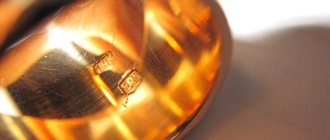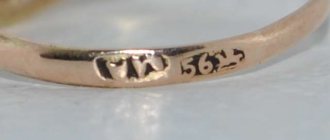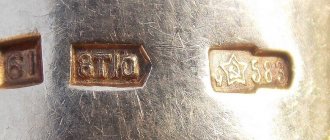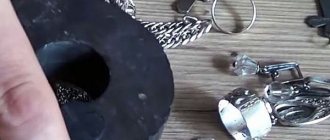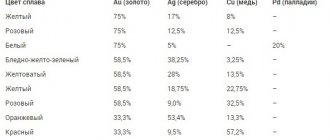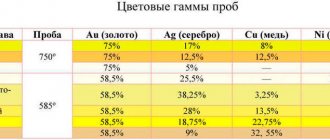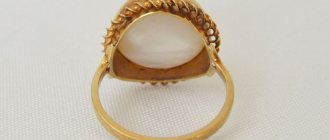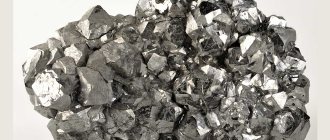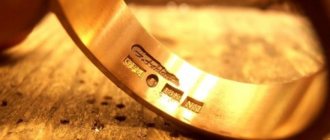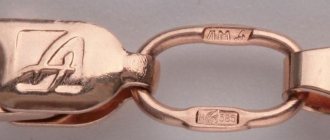Gold accompanies humanity throughout the development of civilization. Products made from this precious metal adorn women's and men's necks, ears and hands and are a demonstration of not only the taste of their owner, but also his material condition.
Among jewelry, there are handicrafts in which the main value is only the mass of the product, but there are also examples of the highest jewelry art. When purchasing both, most consumers are interested in what standard their ring or chain will have.
What standard of gold is considered the best?
Depends on what the noble metal will be used for. For the manufacture of rings, earrings, bracelets and other jewelry, 585 and 750 gold are most suitable, as they will provide the product with the necessary strength and spectacular appearance.
For fine jewelry work, you can use 916 gold, however, provided that the elements made from this alloy are not subject to constant stress and wear. Of course, pure 999 gold is the purest and most expensive, but it is practically useless for jewelry and is used primarily as an investment tool.
Where can you buy or sell
Russian jewelers rarely use the 417th standard, so it is difficult to find it in regular jewelry stores. You should look for such products in a pawn shop, antique dealers and private craftsmen. Among them there are both rare products of the last century and new ones. A large selection of 10 carat metal is available among foreign sellers.
Selling metal is more difficult than buying. In Russia, 10 carats are little known and are not in great demand. Not every pawn shop accepts them. You can also look for buyers on sites selling things or among antique connoisseurs.
How much does 1 gram of gold of this standard cost today?
Cheaper than the 585th sample, and more expensive than the 375th. The metal is popular all over the world, and the price of each sample, including 10 carats, is gradually increasing over time.
Tips for choosing gold jewelry
Jewelry stores amaze with their assortment, and it is difficult to make the right choice.
You need to know a few points so as not to make mistakes:
- Jewelry cannot be exchanged or returned to the store. Buy them only if you are confident in your choice;
- check the brand. Its presence indicates that the product is not a fake and is truly made of high-quality metal;
- pay attention to the tag - this is the “passport” of the jewelry;
- inspect the product carefully. Look at how the clasp is attached and how the stones are attached.
Recommendations for care, cleaning and storage
Gold itself does not require special care. However, due to the components included in its composition, stains, darkening or tarnishing may occur. This can be prevented with proper care.
Jewelry must be worn temporarily. Remove before cleaning the house or playing sports. Protect from sudden changes in temperature, direct sunlight, dust and falls.
To remove dirt from the surface, you need to rinse the product in a soapy solution. A few drops of ammonia will enhance the shine. Folk remedies like toothpaste and baking soda should be used with caution. Usually a soap solution is enough to remove dirt.
The product should be stored in a box, in a separate bag, so that harder metals do not scratch the surface.
What do consumers choose in different countries?
Despite the fact that in past years the most common hallmark in the vastness of the USSR was the 583rd, GOST provided for about 20 gradations of precious metal purity. For jewelry purposes, 5 samples were used:
- 375;
- 583;
- 585;
- 750;
- 958.
Currently, the 999th standard has been added to Russian jewelry standards.
And today, products with a 58.5 percent gold content in jewelry are popular, but products of 750 purity (18 K) occupy an increasingly important place in the jewelry market. It is also extremely common in Europe and Egypt. In the countries of the Middle and Far East, as well as southern Asia, jewelers make jewelry from metal of 21 K and higher. Among Europeans, the Portuguese are the most sensitive to the purity of gold: they prefer products with an 80 percent content (19.2 K) of the 79th element. And in Germany you can buy an 8-carat ring. The United States and the United Kingdom do not have the highest requirements for the purity of precious metals, however, jewelry with a caratature of less than 10 K cannot be sold in an American jewelry store.
It is worth noting that the number of carats is applied not only to “pure” gold products, but also to gold-plated jewelry: a conscientious manufacturer labels its products indicating the share of karat precious metal in the total mass. In this case, a fraction is placed before the number K (1/10 14 K GF means that the total weight of the gold-plated ring or earring contains 1/10 of 14 karat gold).
Application technologies
Modern jewelry manufacturers use one of three methods of applying stamps. Which technology will be used depends on various factors, the determining ones being the type of jewelry and the precious metal used. The most high-grade jewelry is very soft and fragile, so mechanical processing is not always suitable for them. The main methods of branding are:
- shock-mechanical;
- laser;
- electroerosive.
The mechanical impact method involves physical impact on the metal in order to obtain the desired impression. Stamps are applied with hammers or on special machines designed for mass production. Mechanical application was first used in the 17th century and remains the most popular technology in our time. Almost 85% of all manufactured gold products are branded using this method. The tags are durable and easily visible. Anvils of different shapes and sizes allow you to obtain the desired images with little risk of metal deformation.
Electroerosion technology involves burning out prints with a spark. The markings also appear clear and durable. This method is preferred when you need to apply meaning and image to particularly fragile jewelry. But when using electrical discharge machining, it is important that the surface is perfectly polished, without casting defects or the slightest roughness. The technology was first applied and mastered in 1967, so it is considered relatively young.
The laser method is an innovative branding method made possible by the development of high-precision laser equipment. It allows you to print minimally sized images that can be clearly read when using special magnifying devices. The laser can make up to 600 impressions in 1 work shift.
The surface of the product must be pre-polished and cleaned, because after branding it is impossible to grind and polish the metal. With the help of modern installations, it is possible to print even on hollow products, and the main advantage is the ability to place the image on both the concave and convex sides.
How to calculate?
It is known that the hallmark indicates the number of grams of gold or other precious metal in the alloy, while the carat is a unit of measurement of the purity of gold, it demonstrates the content of the precious part in the product.
10k gold ring
There are the following standard markings of aurum, expressed in carats: 24, 18, 14, 12, 9, 8. In this scale, 24 is equal to 999 fineness - an indicator characteristic of pure gold. Converting units of measurement of metal purity into grams is not difficult, the main thing is to know the formula that allows you to do this.
The formula looks like this: 24/1000 = X/Y. In this case, X is the carat indicator, and Y is the fineness. So, if we need to get ahead of the marking, knowing the number of units (10), we need to perform several mathematical operations using the following formula:
Y = 1000*10/24= 417.
In fact, 417 markings are not found in Russia and the CIS countries, although such a metal alloy is manufactured abroad. What properties can such raw materials have? First of all, the alloy consists of only 41.7% of the precious component, while the alloy accounts for 58.3% of the composition. Its properties will be similar to that of the metal marked 375.
The features of low-quality aurum include good workability due to the high content of copper - a strong and wear-resistant metal. But do not forget that 417 gold is characterized by a large amount of alloy, the components of which (the same copper) are prone to rapid oxidation. This leads to damage to the appearance of products made from low-quality metal. The alloy, which contains less gold than ligatures, is widely used in the manufacture of settings for semi-precious and decorative stones, jewelry with semi-precious stones and other accessories. Metal marked 417 is popular in countries such as Turkey, UK, China, Thailand, etc.
Rings with different alloys
If jewelry made from alloy 417 comes into Russia from abroad, then they are all controlled by the Assay Office of the Russian Federation. After checking the authenticity of the products, they are stamped with the marking 375 (standard).
Who tests?
In Russia, the gold marking process is regulated by the State Assay Office under the Ministry of Finance. It is this state assay supervision body that carries out analysis, testing, and hallmarking of gold products.
A hallmark on a piece of jewelry is a guarantee that it is truly made from the appropriate precious alloy. If the sample is missing, looks fuzzy or suspicious, then you may have a fake. You can check the sample of the product at the assay office.
Where is gold usually sampled? Most often - on the inner surface of a ring, on a link in earrings, on a link near a lock in chains and bracelets. To preserve the aesthetic appearance of the decoration, the markings are made miniature.
Basic samples of noble metals.
In Russia, the following metal samples are established by law:
- Gold: for jewelry - 375,500,583, 750, 916, 958, for bars, coins - 999 standard.
- Silver: 800, 830, 875, 925, 960, 999.
- Platinum: 585, 850, 900, 950.
- Palladium: 500, 850.
375 standard contains 38% noble metal. The alloy is yellow in color and contains copper and silver. Over time, the product becomes dull due to the formation of iron sulfide on the surface.
500 standard contains 50% precious metal with the addition of copper and silver.
585 standard is the most popular in Russia. It contains 58.5% gold, and the rest is silver, copper, palladium. This composition makes it durable and easy to manufacture.
750 standard is expensive due to the presence of noble metals, including platinum, palladium, copper, nickel, and silver.
958 and higher are not used in the jewelry industry due to their unattractive appearance. This metal is used to make bullion and coins for investment.
999 standard is the metal itself without impurities or additives. It has a high cost, but is not used in production.
Types and forms of brands
Precious jewelry is marked not only with gold hallmark numbers. All products must be branded. The applied mark may have a different shape, depending on the country of origin and the designation system adopted there. In Russia, two types of printing are most often found:
- image of a female profile facing the right side;
- a hammer and sickle located on a five-pointed star.
Regardless of the shape and type, the mark must contain mandatory information: the code of the service that applied the seal, the marking of the content of precious metal in the alloy used and the symbol of the assay service’s identification. The cost of products is directly proportional to the percentage of precious metal.
It is almost impossible for a simple buyer who has no experience working with jewelry to determine the authenticity of the applied mark. Often very good and high-quality fakes with 585 or even 750 purity are passed off as real gold. In fact, scammers have learned to illegally apply samples and deceive consumers. To check whether the value of the mark corresponds to the true content of the precious metal, a visual inspection with magnifying devices and additional testing procedures will be required.
The surface of the gold object is first cleaned, then passed over the surface of a special stone. There should be gold stripes left on it, onto which you need to apply reagents. If the sample is high, then the remaining strokes will not disappear and will not even change color. If the strips have completely dissolved, it means that the product is of low quality or does not contain yellow metal at all. At home, it is extremely difficult to determine the quality of products , and it is not even always clear whether it is gold or silver. The 325th standard is the lowest that is allowed in jewelry production; it may outwardly look like a gold-plated silver product.
325 gold items are in demand and highly valued in England and some other countries. In Russia, this metal is considered low-grade. Separately, we can highlight jewelry with the designation 588. They are made of a high-quality alloy, including 11 parts of yellow metal and 1 part of elite platinum. The cost of such goods is much higher. Elite items also include items marked 983; their price can be extremely high due to the use of noble red gold.
Composition of gold alloys
In addition to gold, jewelry alloys contain a ligature, which can consist of:
- platinum (increases elasticity, discolors gold, increases melting point);
- silver (increases ductility, makes the alloy more malleable and easier to process, gives a white tint);
- palladium (brightens, imparts plasticity, increases the melting point);
- nickel (gives hardness, “whitens”, increases resistance to corrosion, but can cause an allergic reaction);
- cadmium (thanks to it, the alloy melts easier, it also gives a greenish tint);
- copper (increases hardness, gives a reddish tint, reduces anti-corrosion properties);
- zinc (improves the fluidity of the metal, reduces the melting point, can give a greenish tint).
These additives increase the consumer properties of the alloy - making it stronger, more durable, and resistant to wear. The hallmark designation in numbers is applied to each piece of jewelry, as required by the legislation of the Russian Federation (all products made from alloys containing more than 30% precious metal must be stamped).
Measurement in spools
It is necessary to add a few words about another standard for the purity of gold in jewelry, although it became outdated almost 100 years ago, but perhaps someone will have to deal with purchasing works from Russian jewelry workshops of the pre-revolutionary period. Back in the first quarter of the 20th century in Russia, the content of pure gold in jewelry was measured in spools. In this system, a 24-karat product was labeled as 96-spool. The most popular samples translated into Russian units will look like this:
- 14 K (585) - 56 spools;
- 18 K (750) - 72.
The percentage of pure metal in the total mass of the product in this case is also calculated using the formula 1000X/Y (X is the number of spools, Y is 96).
It is perhaps necessary to say that the color of gold jewelry does not depend on the sample to the same extent as “experts” claim, dividing the precious metal by quality into “white” gold or “pink”. The shade here only depends on the composition of the ligature. It does not affect the quality of the product, and the choice of decoration should only be influenced by consumer preferences.
How many carats are in diamonds and gems?
In English, different spellings of words help you avoid getting confused about carats. The word carat is used to define the mass of stones, and karat for gold.
Carat is a measure used to indicate the weight of precious stones and gems. It is equal to 200 milligrams (0.2 grams).
A sapphire, ruby and diamond of the same size will have different carats because their densities are different. If you place gemstones of the same weight of 1 carat next to each other, the largest will be an emerald, followed by a diamond, and the smallest will be a ruby.
A diamond weighing more than one carat is considered large. Its diameter can reach 0.5 cm. Diamonds weighing 5 carats are sold only at auctions. But stones weighing more than 25 carats receive their own names.
The larger the gem, the more expensive its price. The largest diamond in the world weighs 545 carats.
Diamonds in carats
The weight of semi-precious stones is also measured in carats. But their weight does not affect the cost so much. Other factors also play a role here: brightness of color, shape, cut.
Granules are used to measure the mass of natural pearls. It is equal to a quarter of a carat. But no one measures raw stones in carats. Their weight is measured in grams.
A little about the metric system
Souvenirs and gifts made of gold are often brought from trips abroad, but in foreign jewelry stores, compatriots are faced with a different system for measuring gold purity - in carats. Everyone knows that in the territory of the former Soviet Union there was a metric system of measures, according to which the sample was designated by a three-digit number (583 or 375). This meant that in every thousand parts of the finished product there are 583 or 375 parts of gold itself.
Everything was simple and clear until citizens had the opportunity or even the need to purchase gold items in countries with other units of measures. For example, Britain, the United States and some other countries still use the English measurement system, and in Europe, which has switched to the metric system, jewelers also use graduations in carats.
A Russian or Kazakh buyer with little familiarity with English measures would have a very difficult time determining the purity of 10 carat gold earrings in a jewelry store somewhere in California or Wales, so he needs to learn more about these standards.
